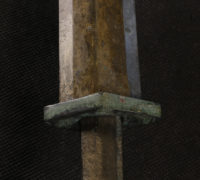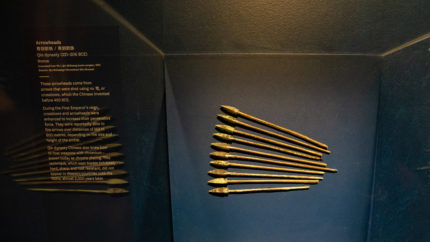 Since the fearsome 2,000-strong terracotta army of Emperor Qin Shihuang (259–210 B.C.) was first excavated in the 1970s, the bronze weaponry has stood out for its remarkably good state of preservation. Tens of thousands of arrowheads, spear tips, lances, swords, hooks, crossbow triggers and other bronze parts of complex weapons have survived even as their wooden components decayed to nothingness. Many are still shiny, sharp and show no sign of corrosion whatsoever. Traces of chromium found on the bronze parts have led scholars to hypothesize that the unusually excellent condition was attributable to an early form of chrome plating used as an anti-oxidation measure, a technology only otherwise known to have been invented in the 20th century.
Since the fearsome 2,000-strong terracotta army of Emperor Qin Shihuang (259–210 B.C.) was first excavated in the 1970s, the bronze weaponry has stood out for its remarkably good state of preservation. Tens of thousands of arrowheads, spear tips, lances, swords, hooks, crossbow triggers and other bronze parts of complex weapons have survived even as their wooden components decayed to nothingness. Many are still shiny, sharp and show no sign of corrosion whatsoever. Traces of chromium found on the bronze parts have led scholars to hypothesize that the unusually excellent condition was attributable to an early form of chrome plating used as an anti-oxidation measure, a technology only otherwise known to have been invented in the 20th century.
A new study published in Scientific Reports suggests that the chromium residue found on the blades was an element in the lacquer applied to the wood or bamboo parts of the weapons — grips, spear handles, lance and arrow shafts, crossbows, etc. — not to the bronze edged parts. In the decay of the organic material, the chromium residue contaminated the blades.
In the absence of an anachronistically advanced rust-prevention technology, what then has kept blades and points in such pristine condition? The study authors think the answer is in the composition of the bronze and in the soil itself. Bronzes with higher tin content are prone to develop rich-tin layers on the surface that prevent corrosion. Testing of the surface of batches of bronze arrows from the Terracotta Army archers found the ones with the higher tin content were more stable. The presence of arsenic in the bronze also helped prevent corrosion.
The alkali nature of the soil is another highly significant factor that this study is the first to explore.
The Terracotta Army is located in the southern edge of the Chinese Loess Plateau, a 640,000 km2 area covered by silt-sized aeolian sediments that make the bulk of the soil. Large-scale models predict pH values around 8–9 for the Lintong area43, and this was confirmed by our on-site measurements of soil samples from Pits 1 and 2, showing pH values between 8.1 and 8.5 (Table S3). Burial soil pH is a paramount parameter predicting metal preservation, as it is correlated with redox potential, drainage conditions, biological activity and aeration. Additional characteristics of loess of potential relevance here are its low organic content and predominantly very small particle size. We propose that the moderate basicity and low organic content of the loess would have prevented the formation of acids that would attack metal integrity. In addition, the very small particle size of the soil would have obstructed the aeration and humidity necessary for metal corrosion. Our proposal is consistent with studies in conservation science which have addressed the optimum conditions for metal preservation in burial environments, noting pH levels of 8–8.5 and small particle size as optimum.
The research team tested the claim by placing bronze tokens in an environmental chamber that created accelerated aging conditions and by burying bronze in soil excavated from Pit 1 of the tomb. The tokens and the buried bronze both remained in pristine condition. A bronze token buried in organic-rich, slightly acidic soil with a pH of 5.9 as a control, on the other hand, quickly showed signs of corrosion.
In conclusion, the perplexing suggestion that Qin weapon makers used an arcane chromium-based technology to prevent weapon rust has been refuted. Efforts should be made to update museum displays and other popular literature about the site with this new information. Furthermore, we predict that chromium will be detected on the surface of metal objects from other sites where they may have been in association with chromium-bearing lacquered parts, i.e. more likely on weapons than on ritual bronzes. The use of chromium-rich compounds in the manufacture of ancient lacquer should be in the agenda for future research, together with further technological study of the sharp and lustrous blades.
